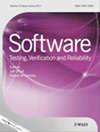Assessing test suites of extended finite state machines against model‐ and code‐based faults
IF 1.2
4区 计算机科学
Q3 COMPUTER SCIENCE, SOFTWARE ENGINEERING
引用次数: 3
Abstract
Tests can be derived from extended finite state machine (EFSM) specifications considering the coverage of single‐transfer faults, all transitions using a transition tour, all‐uses, edge‐pair, and prime path with side trip. We provide novel empirical assessments of the effectiveness of these test suites. The first assessment determines for each pair of test suites if there is a difference between the pair in covering EFSM faults of six EFSM specifications. If the difference is found significant, we determine which test suite outperforms the other. The second assessment is similar to the first; yet, it is carried out against code faults of 12 Java implementations of the specifications. Besides, two assessments are provided to determine whether test suites have better coverage of certain classes of EFSM (or code) faults than others. The evaluation uses proper data transformation of mutation scores and p‐value adjustments for controlling Type I error due to multiple tests. Furthermore, we show that subsuming mutants have an impact on mutation scores of both EFSM and code faults; and accordingly, we use a score that removes them in order not to invalidate the obtained results. The assessments show that all‐uses tests were outperformed by all other tests; transition tours outperformed both edge‐pair and prime path with side trips; and single‐transfer fault tests outperformed all other test suites. Similar results are obtained over the considered EFSM and code fault domains, and there were no significant differences between the test suites coverage of different classes of EFSM and code faults.针对基于模型和代码的错误评估扩展有限状态机的测试套件
测试可以从扩展有限状态机(EFSM)规范中导出,考虑到单传输故障的覆盖范围,使用转换巡回的所有转换,所有使用,边缘对和带侧跳闸的主要路径。我们对这些测试套件的有效性提供了新颖的经验评估。第一个评估确定每对测试套件在覆盖6个EFSM规范的EFSM错误方面是否存在差异。如果发现差异显著,我们确定哪个测试套件优于其他测试套件。第二种评估与第一种类似;然而,它是针对规范的12个Java实现的代码错误执行的。此外,提供了两种评估来确定测试套件是否比其他测试套件更好地覆盖某些类型的EFSM(或代码)错误。评估使用适当的突变分数数据转换和p值调整来控制由于多次测试导致的I型误差。此外,我们发现包含突变体对EFSM和代码错误的突变分数都有影响;因此,为了不使获得的结果无效,我们使用一个分数来删除它们。评估表明,所有用途测试的表现都优于所有其他测试;过渡行程优于边对和主路径的支线行程;单传输故障测试优于所有其他测试套件。在考虑的EFSM和代码错误域上获得了类似的结果,并且在不同类型的EFSM和代码错误的测试套件覆盖率之间没有显着差异。
本文章由计算机程序翻译,如有差异,请以英文原文为准。
求助全文
约1分钟内获得全文
求助全文
来源期刊

Software Testing Verification & Reliability
工程技术-计算机:软件工程
CiteScore
3.70
自引率
0.00%
发文量
34
审稿时长
>12 weeks
期刊介绍:
The journal is the premier outlet for research results on the subjects of testing, verification and reliability. Readers will find useful research on issues pertaining to building better software and evaluating it.
The journal is unique in its emphasis on theoretical foundations and applications to real-world software development. The balance of theory, empirical work, and practical applications provide readers with better techniques for testing, verifying and improving the reliability of software.
The journal targets researchers, practitioners, educators and students that have a vested interest in results generated by high-quality testing, verification and reliability modeling and evaluation of software. Topics of special interest include, but are not limited to:
-New criteria for software testing and verification
-Application of existing software testing and verification techniques to new types of software, including web applications, web services, embedded software, aspect-oriented software, and software architectures
-Model based testing
-Formal verification techniques such as model-checking
-Comparison of testing and verification techniques
-Measurement of and metrics for testing, verification and reliability
-Industrial experience with cutting edge techniques
-Descriptions and evaluations of commercial and open-source software testing tools
-Reliability modeling, measurement and application
-Testing and verification of software security
-Automated test data generation
-Process issues and methods
-Non-functional testing
 求助内容:
求助内容: 应助结果提醒方式:
应助结果提醒方式:


